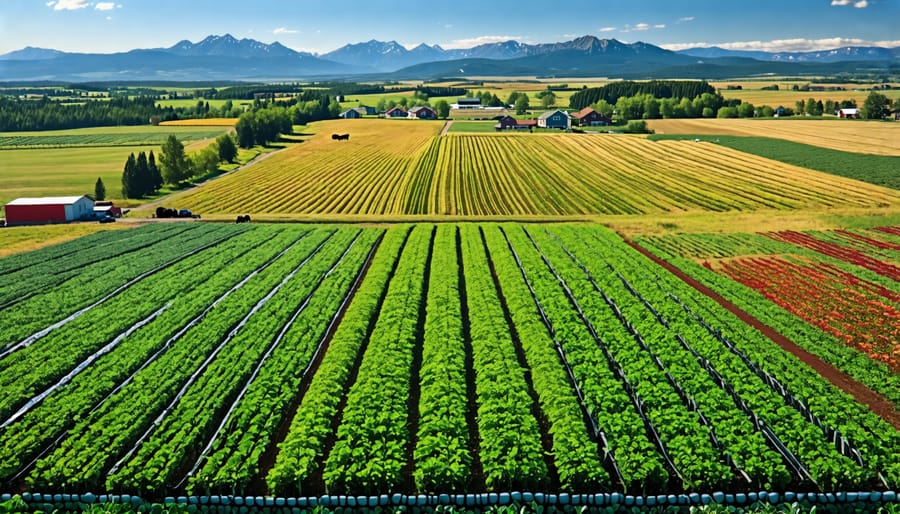Boost soil health through cover cropping, composting, and minimal tillage to promote nutrient cycling and microbial activity. Implement integrated pest management strategies like crop rotation, intercropping, and beneficial insect habitats to control pests and diseases naturally. Conserve water by using drip irrigation, mulching, and selecting drought-resistant crop varieties suited to Alberta’s climate. Manage livestock holistically with rotational grazing, pasture diversity, and animal welfare practices that enhance soil fertility and biodiversity.
Building Healthy Soil
Crop Rotation
Crop rotation is a powerful tool for replenishing soil nutrients in organic farming systems. By strategically alternating crops each season, farmers can optimize nutrient uptake and minimize depletion. For example, planting nitrogen-fixing legumes like peas or lentils after heavy feeders such as wheat or canola helps restore nitrogen levels. This reduces the need for external inputs and promotes long-term soil health.
In Alberta, many farmers follow a four-year rotation cycle that includes cereals, oilseeds, pulses, and cover crops. Cover crops, like clover or alfalfa, protect the soil from erosion and add organic matter when tilled under. This enhances soil structure, water retention, and nutrient availability for subsequent crops.
Crop rotation also helps break pest and disease cycles, as many organisms are crop-specific. By changing the host plant regularly, farmers can minimize pest populations and reduce the need for interventions. Ultimately, well-planned crop rotation is a cornerstone of sustainable organic farming that benefits both the land and the farmer’s bottom line.
Cover Cropping
Cover cropping is a powerful organic farming technique that offers multiple benefits for soil health and sustainability. By planting fast-growing crops like legumes, grasses, or brassicas between main crop rotations, farmers can protect their soil from erosion caused by wind and rain. These cover crops form a dense canopy, shielding the soil and reducing the impact of heavy rainfall or strong winds. As the cover crops grow, their roots help stabilize the soil structure, preventing valuable topsoil from being washed or blown away. When the cover crops are eventually mowed down or tilled into the soil, they decompose and add organic matter, improving soil fertility and water retention. This process also helps to suppress weeds and break pest cycles, reducing the need for chemical interventions. By incorporating cover cropping into their organic farming practices, Alberta farmers can build healthier, more resilient soils that support sustainable crop production for years to come.

Composting
Composting is a cornerstone of organic farming, transforming organic waste into nutrient-dense soil amendments. By recycling plant debris, kitchen scraps, and manure, farmers can create a closed-loop system that nourishes their crops and improves soil structure. Effective composting requires a balance of carbon and nitrogen-rich materials, adequate moisture, and proper aeration. Regularly turning the compost pile ensures even decomposition and prevents anaerobic conditions. Farmers can also employ vermicomposting, harnessing the power of worms to break down organic matter. Applying mature compost to fields enhances soil fertility, boosts microbial activity, and improves water retention. Discover more natural farming secrets to revitalize your soil and optimize your composting efforts.
Natural Pest and Weed Control
Companion Planting
Companion planting is a powerful organic farming technique that harnesses the natural synergies between plants to deter pests and promote healthy growth. By strategically pairing certain crops, Alberta farmers can create a diverse ecosystem that reduces the need for synthetic pesticides. For example, planting basil alongside tomatoes can repel aphids and whiteflies, while marigolds interspersed with vegetables help keep nematodes at bay. Legumes like peas and beans fix nitrogen in the soil, benefiting nearby crops. Companion planting not only minimizes pest damage but also attracts beneficial insects like ladybugs and lacewings, which prey on common garden pests. This age-old practice fosters biodiversity, improves soil health, and enhances the overall resilience of your farm. As Canadian organic farmer Sarah Johnson shares, “Companion planting has been a game-changer for our operation. We’ve seen a significant reduction in pest pressure and healthier, more abundant harvests since implementing this technique.”

Beneficial Insects
Beneficial insects play a crucial role in organic pest management. Ladybugs, lacewings, and parasitic wasps are just a few examples of predatory insects that can help keep pest populations in check. To attract these helpful critters, plant a diverse range of flowering plants around your crops, providing them with nectar and pollen sources. Herbs like dill, fennel, and cilantro are particularly attractive to beneficial insects. You can also create insect hotels using hollow stems, wood blocks, or cardboard tubes to provide shelter for these tiny allies. By encouraging a balanced ecosystem, you can reduce the need for chemical interventions and maintain a healthier, more resilient farm. Canadian organic farmers have seen great success with this approach, as demonstrated by the thriving organic farms in Alberta’s Peace River region, where ladybugs and other beneficial insects help keep aphids and other pests at bay.
Mechanical Weed Control
Mechanical weed control techniques, such as tillage, mowing, and mulching, offer effective non-chemical strategies for suppressing weeds in organic farming systems. Tillage, using tools like cultivators or harrows, disrupts weed growth and prevents seed germination. Mowing regularly cuts back weeds before they set seed, gradually depleting the weed seed bank. Applying organic mulches, like straw or compost, smothers weeds and enhances soil health. Flame weeding, which uses targeted heat to kill weeds, is another option. Combining these methods in a well-timed, integrated approach maximizes weed control efficacy. Consult with local organic farming associations or agricultural extension services for tailored guidance on implementing mechanical weed control strategies in your Alberta farming operation.
Efficient Irrigation Techniques
Drip Irrigation
Drip irrigation is a highly efficient watering method that delivers precise amounts of water directly to plant roots, minimizing evaporation and runoff. By targeting water application, farmers can reduce their overall water consumption by up to 60% compared to traditional sprinkler systems. This conservation technique is particularly valuable in regions like Alberta, where water scarcity can be a concern during dry seasons.
In addition to saving water, drip irrigation promotes healthier plant growth by maintaining consistent soil moisture levels and reducing the risk of fungal diseases associated with overwatering. The controlled release of water also helps prevent nutrient leaching, ensuring that plants receive the necessary nutrients for optimal development.
Implementing drip irrigation systems may require an initial investment, but the long-term benefits in terms of water savings, improved crop yields, and reduced labor costs make it a worthwhile consideration for organic farmers seeking to enhance their sustainability practices.
Mulching
Mulching is a simple yet effective organic farming technique that involves covering the soil surface with a layer of organic material, such as straw, leaves, or compost. By doing so, farmers can significantly reduce water evaporation from the soil, helping to retain moisture and reduce the need for frequent irrigation. Organic mulches also help regulate soil temperature, preventing extreme fluctuations that can stress plants and inhibit growth.
In addition to conserving water, mulching suppresses weed growth by blocking sunlight from reaching the soil surface. This can greatly reduce the time and effort required for manual weeding or the need for herbicides. As the mulch breaks down over time, it also adds valuable organic matter to the soil, improving its structure, fertility, and overall health.
When applying mulch, aim for a layer about 5-10 cm (2-4 inches) deep, taking care not to pile it against plant stems or tree trunks to prevent rot. By incorporating mulching into their organic farming practices, farmers can create a more resilient and sustainable growing environment while conserving resources and reducing labor.
Organic Livestock Management
Pasture Rotation
Rotational grazing is a key strategy for maintaining healthy, productive pastures in organic farming systems. By dividing pastures into smaller sections and moving livestock between them on a regular schedule, farmers can prevent overgrazing and allow grass time to recover. This not only improves forage quality and quantity but also enhances soil health by promoting deeper root growth and nutrient cycling. Farmers in Alberta have found success implementing rotational grazing with the help of portable electric fencing and water systems. “It takes some extra planning and labor, but the benefits to pasture productivity and animal health are well worth it,” says John Smith, an organic rancher near Edmonton. To get started with rotational grazing, assess your pasture resources, determine an appropriate stocking rate, and create a grazing plan that aligns with your goals. Seeking advice from experienced graziers or agricultural professionals can also help ensure a smooth transition to this sustainable pasture management approach.

Natural Parasite Control
Organic farmers in Alberta can effectively manage livestock parasites through a combination of preventative measures and natural treatments. Rotational grazing is key, allowing pastures to rest and breaking parasite lifecycles. Planting diverse forage species, like chicory and birdsfoot trefoil, can also reduce parasite loads. Herbal remedies, such as garlic, wormwood, and black walnut hull, can be administered to treat infections. Monitoring livestock health through regular fecal egg counts helps catch issues early. Boosting animal immunity with proper nutrition, particularly mineral balancing, is crucial. Ducks, chickens, and dung beetles act as natural parasite control when integrated into pasture systems. By implementing these strategies and working with local veterinarians and experienced organic farmers, Alberta producers can successfully control parasites without relying on chemical dewormers. Transitioning to natural parasite management takes time and patience, but the long-term benefits to animal health, soil ecology, and farm sustainability make it a worthwhile investment.
Holistic Health Management
In organic farming, a holistic approach to livestock health management is essential. This involves implementing proactive strategies to support animal well-being and prevent disease. Regular monitoring of livestock health, including assessing body condition, behavior, and feed intake, allows farmers to identify and address potential issues early on. Providing animals with access to clean water, fresh air, and ample space to engage in natural behaviors promotes both physical and mental health. Nutrition also plays a critical role; feeding livestock a balanced, species-appropriate diet that includes high-quality forage and necessary supplements supports optimal health and resilience. By taking a proactive and holistic approach, organic farmers can ensure their livestock thrive in a sustainable and humane manner.
Conclusion
In conclusion, organic farming techniques offer a sustainable and environmentally-friendly approach to agriculture that can benefit Alberta farmers in numerous ways. By prioritizing soil health through practices like crop rotation, cover cropping, and composting, farmers can improve soil structure, fertility, and water retention. Implementing natural pest control methods, such as companion planting and beneficial insect habitats, helps reduce reliance on harmful pesticides while maintaining crop yields. Water conservation techniques, including drip irrigation and mulching, ensure efficient use of this precious resource in the face of changing climate conditions. Lastly, holistic livestock management practices promote animal welfare and contribute to overall farm sustainability.
Adopting these organic farming techniques not only supports the long-term viability of agricultural land but also has the potential to increase profitability for Alberta farmers. By differentiating their products as organic and sustainably produced, farmers can tap into growing consumer demand for healthier, environmentally-conscious food choices. Moreover, the focus on soil health and biodiversity can lead to more resilient farms that are better equipped to withstand the challenges posed by weather extremes and pest outbreaks.
As the organic farming movement continues to gain momentum in Alberta and across Canada, it is crucial for farmers to share knowledge, experiences, and best practices with one another. By fostering a supportive and collaborative community, Alberta farmers can lead the way in demonstrating the viability and benefits of organic agriculture, ultimately contributing to a more sustainable and thriving food system for generations to come.











